|
Driftless SW Wisconsin | We have customers using both dry fertilizer as you did Marc and liquid.
For customers with a suitable air dry fertilizer cart, I think dry is the way to go. You can get about any blend you want and as has been point out our method of application mixes it thoroughly through the strip profile, in most situations.
Below is a photo of a strip being made in some VERY wet ND conditions between standing corn stalks. You can see the pile of fertilizer between the coulters where we stopped. To the rear it is quite thoroughly mixed. Yes you will see some visible on the surface, just like if you put the soil and fertilizer in a blender - you would still see some particles. Urea in particular is often visible since it is usually a pure white color. I will add a second dry photo from this spring.
As far as liquid goes, we have 3 separate points we can apply liquid fertilizers: behind the RH, LH or center coulters. Most customers who have used liquid have been using high pressure injection. I set up a smaller 6 row bar to test with a squeeze pump and low pressure liquid 28% application alongside the RH coulter. I did end up shortening the plastic hose shown to about 2" long and it just dropped the liquid down in the temporarily open slot alongside the coulter where it was sealed in along one side of the strip but NOT mixed. I put about 35 gal/a of 28% (about 110 units of N) down this way. There was no liquid visible on the surface behind the strip till machine - the LH coulter and gage wheel cover it well. In some areas the soil was very wet when stripping. I came back late the next afternoon and planted corn down the middle of the strip. There is no sign of burn in the stand. I think I would prefer this method behind the LH coulter which runs a a different compound angle - less likely to snag stalks although the 2" version was OK in the fields I ran it.
As Greywolf points out, I have had several discussions with fertilizer experts who tell me that IF the N is in contact with moist soil particles, it changes form and is safe to plant in a few days at most. The way we mix the fertilizer in it is usually very likely to be in contact with soil particles. Even the 350 lb photo below was planted the next day if I recall correctly.
As far as ripping/zones & strip till - I am not advocaing one way or the other. We have quite a few customers who fall rip with some sort of minimum disturbance tool running anywhere from 8" to 18" deep either with or without fertilizer.
The fall "ripping" can serve a couple different purposes - one is to break up some sort of preexisting compaction problem. Another reason to "rip" is to blacken up a slot or zone to dry out a bit faster in the spring. Or some combination of the two depending on your location. Some will deep place liquid manure in these slots in the fall, some air deliver dry p & k, most don't put any fertilizer down - just open up a slot.
I personally don't think fall urea is a good idea in most places. You will usually get a little N in the DAP. The ripper is almost never the same width as the planter and does not usually leave a reasonable place to plant. They then run over these slots in the spring with our Dawn strip till units running the same width as the planter to make a fit place to plant and put down either all of their fertilizer or just N as either dry or liquid. Some don't run any fertilizer with the Pluribus.
One advantage to putting all of your fertilizer down as dry mixed in the strip is that it seems you can then get the starter off of the planter. When it comes time to plant you put seed in the ground instead of nursing a lot of corrosive liquid to your new planter. There is usually a much wider time window to make strips than to plant.
Several customers who have been "ripping" in the fall to break up compaction have done exactly what Marc mentions - do it one year, move over 15" the second year and then just do the headlands or high traffic areas. If you do too much ripping it seems like you can almost destroy soil structure rather than improving it. If you are running a fall tool to blacken up a strip to dry quicker in the spring, I would not run it near as deep - maybe vary the depth slightly from year to year. This greatly reduces the hp requirements and works a lot better in the typically drier fall conditions. I would again forget the fall fertilizer and put it all down with the strip till in the spring, this may let you cover more ground in the fall. Then you can forget about trying to make the fall berm "pretty" - just leave it chunky but don't through the soil very far. We need to be able to gather it in in the spring with our units.
Where customers are careful about compaction and combine and cart tracks, we are seeing signs that our units (running at 5" deep and shifted laterally 15" every year or two) along with very much increased earthworm populations due to all residue left on the surface will eliminate the need for regular deeper tillage. We had some interesting feedback from very wet areas this spring - the strip tilled corn looked better than the worked corn.
As far as getting through heavy stalks in the spring - if our units are all in a row on a third party toolbar you need to be able to stay between the old rows. As Marc found, one of the toughest situations is a first year GPS/rtk trying to make arrow-straight rows over the tops of heavy stalks that were planted with marker, or even a lower accuracy auto steer system. Here sometimes the best solution is, as he suggests, to go run a shredder over the stalks - it will make life a lot easier the first year. From then on you can just drive on last years rows or use rtk. Lower accuracy autosteer systems can cause more pain than joy. Sometimes it is best just to shut the thing off and drive on the old rows.
Here are some photos. The second to last photo shows you a dry cart configuration which was used to apply 350 lb/acre of toal n p k product which is shown in the last photo.
Jim at Dawn
Edited by Jim 6/22/2006 23:32
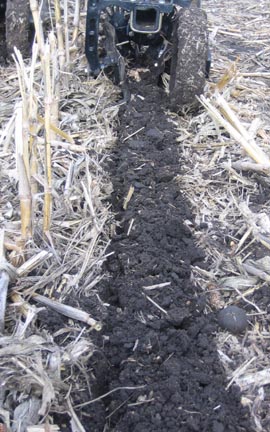 (Dawn 7940-16 Strip Till toolbar w JD1910 cart ND flwrs 150 lb fert dispersion 6-15-05 img_1039.jpg) (Dawn 7940-16 Strip Till toolbar w JD1910 cart ND flwrs 150 lb fert dispersion 6-15-05 img_1039.jpg)
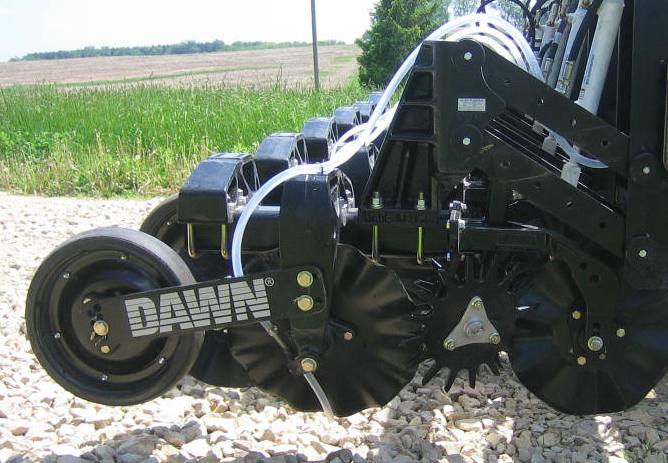 (Dawn Strip Till low pressure liquid RH IMG_2370 0506.JPG) (Dawn Strip Till low pressure liquid RH IMG_2370 0506.JPG)
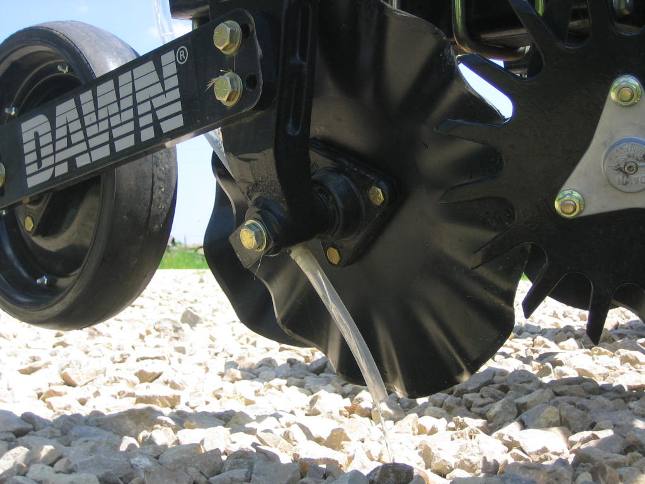 (Dawn Strip Till low pressure liquid RH IMG_2378 0506.JPG) (Dawn Strip Till low pressure liquid RH IMG_2378 0506.JPG)
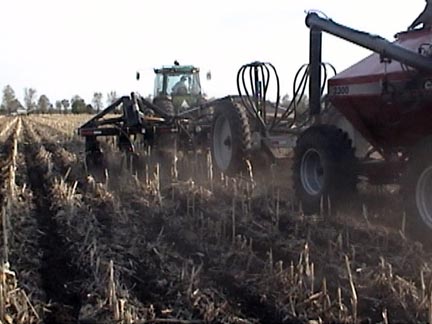 (DAWN STRIP TILL CORN ON CORN ND 042706 LREAR W CART DSC0853.jpg) (DAWN STRIP TILL CORN ON CORN ND 042706 LREAR W CART DSC0853.jpg)
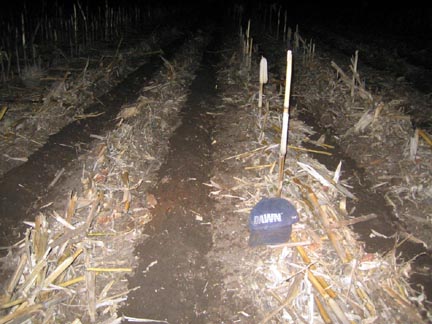 (DAWN STRIP TILL CORN ON CORN ND 042706 HAT STRIP 350LB DRY IMG2177.jpg) (DAWN STRIP TILL CORN ON CORN ND 042706 HAT STRIP 350LB DRY IMG2177.jpg)
Attachments
----------------
 Dawn 7940-16 Strip Till toolbar w JD1910 cart ND flwrs 150 lb fert dispersion 6-15-05 img_1039.jpg (73KB - 973 downloads) Dawn 7940-16 Strip Till toolbar w JD1910 cart ND flwrs 150 lb fert dispersion 6-15-05 img_1039.jpg (73KB - 973 downloads)
 Dawn Strip Till low pressure liquid RH IMG_2370 0506.JPG (60KB - 994 downloads) Dawn Strip Till low pressure liquid RH IMG_2370 0506.JPG (60KB - 994 downloads)
 Dawn Strip Till low pressure liquid RH IMG_2378 0506.JPG (51KB - 1001 downloads) Dawn Strip Till low pressure liquid RH IMG_2378 0506.JPG (51KB - 1001 downloads)
 DAWN STRIP TILL CORN ON CORN ND 042706 LREAR W CART DSC0853.jpg (64KB - 901 downloads) DAWN STRIP TILL CORN ON CORN ND 042706 LREAR W CART DSC0853.jpg (64KB - 901 downloads)
 DAWN STRIP TILL CORN ON CORN ND 042706 HAT STRIP 350LB DRY IMG2177.jpg (73KB - 902 downloads) DAWN STRIP TILL CORN ON CORN ND 042706 HAT STRIP 350LB DRY IMG2177.jpg (73KB - 902 downloads)
| |
|


 Strip til Pics finally
Strip til Pics finally